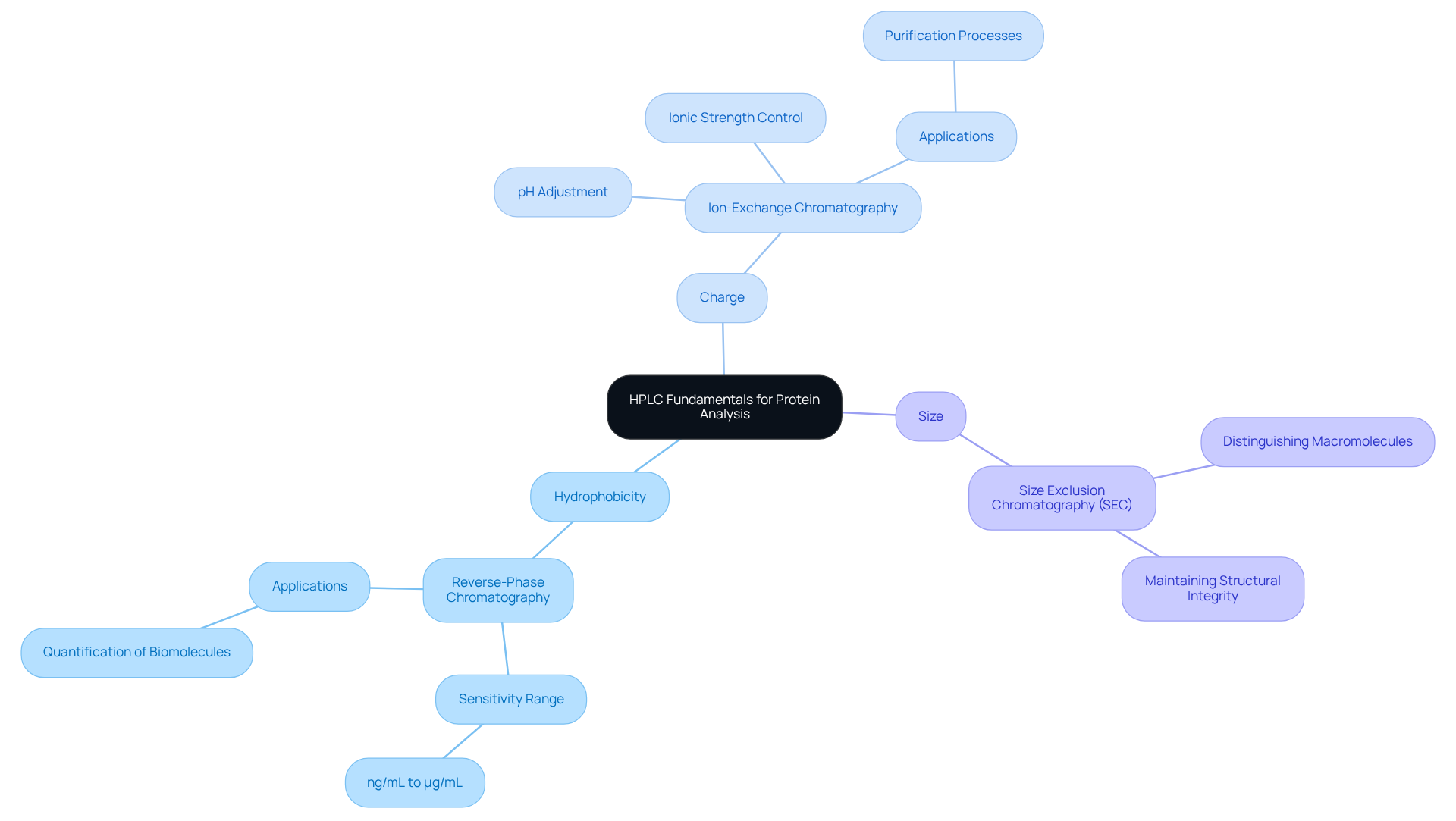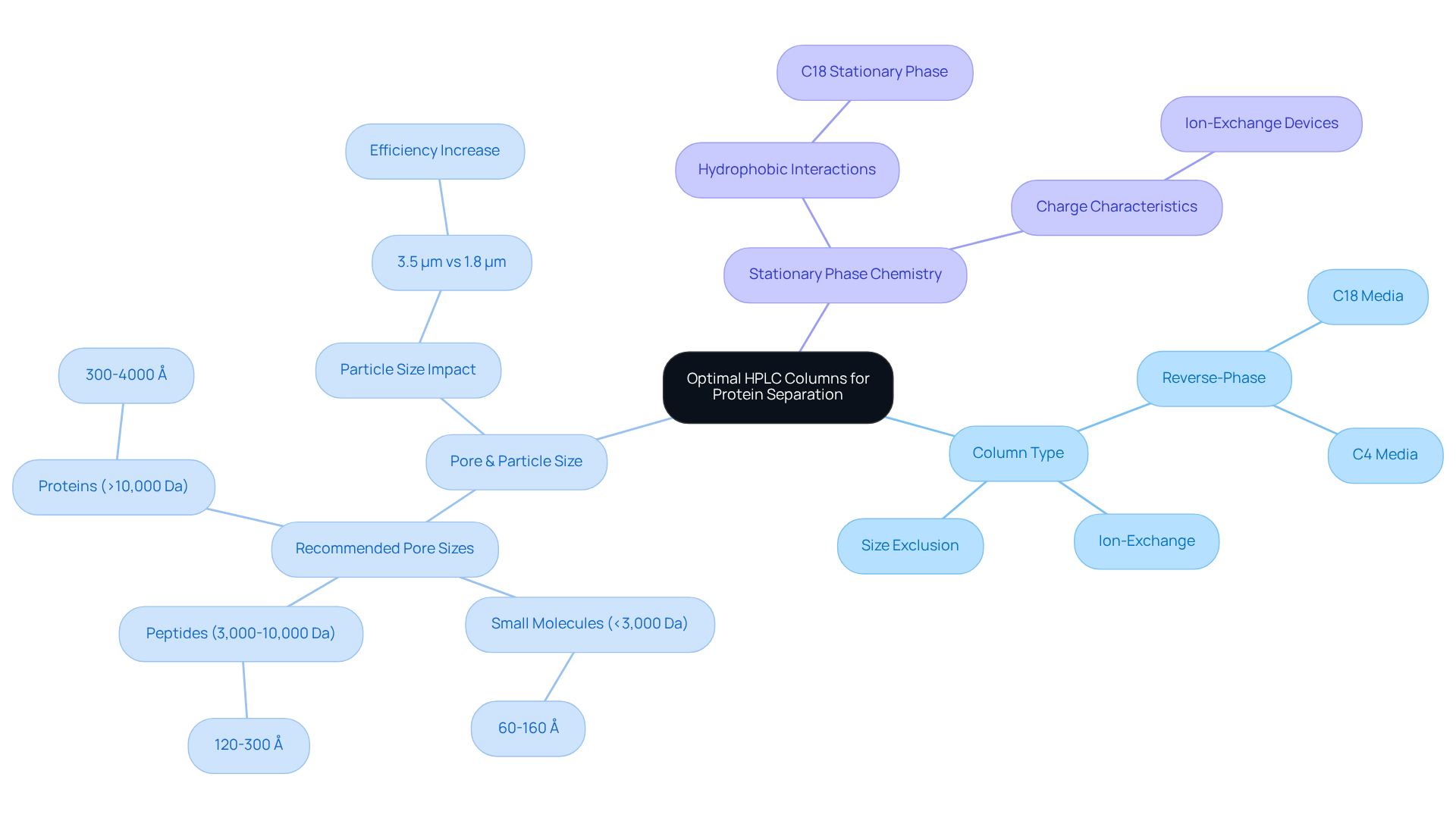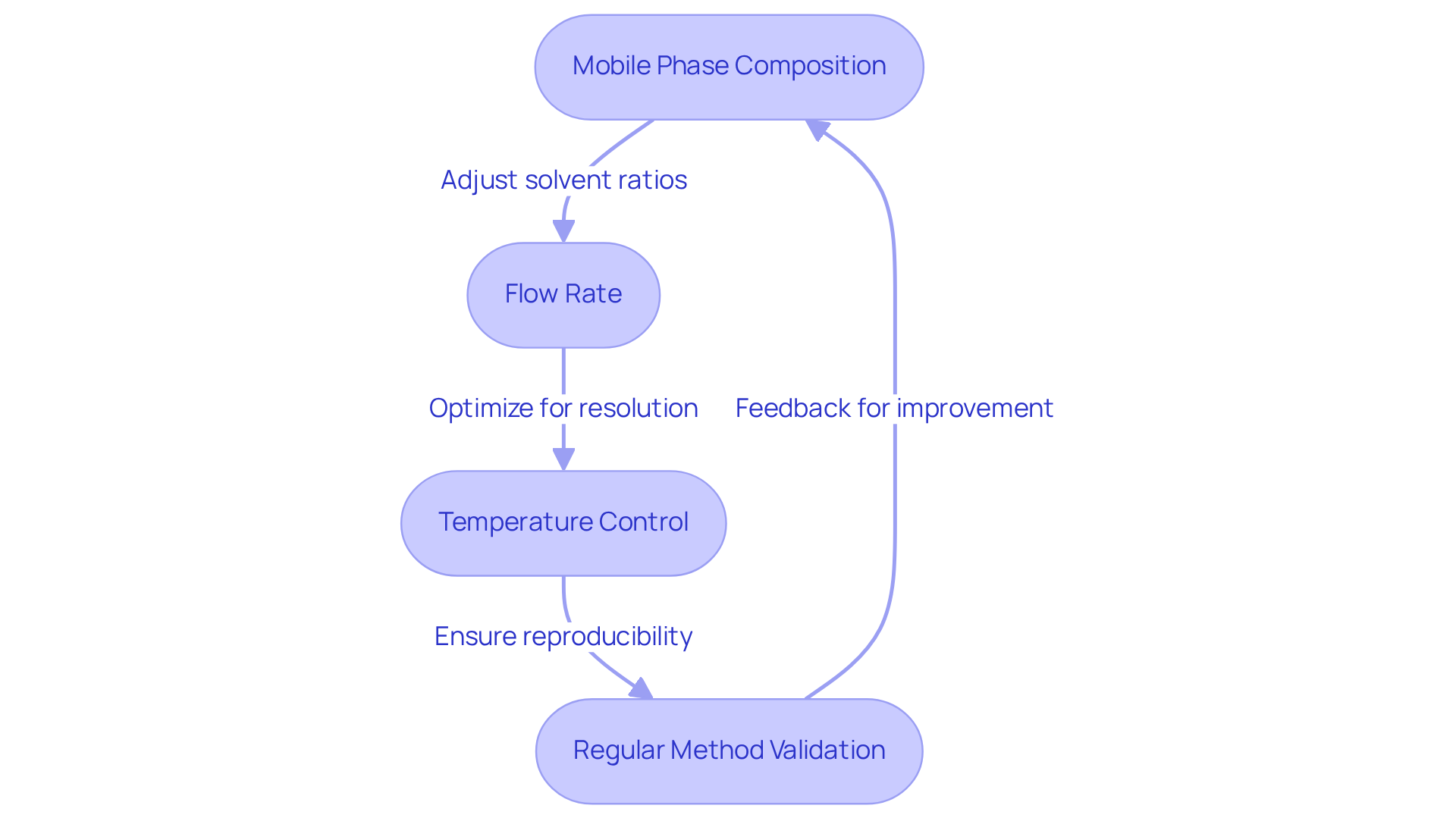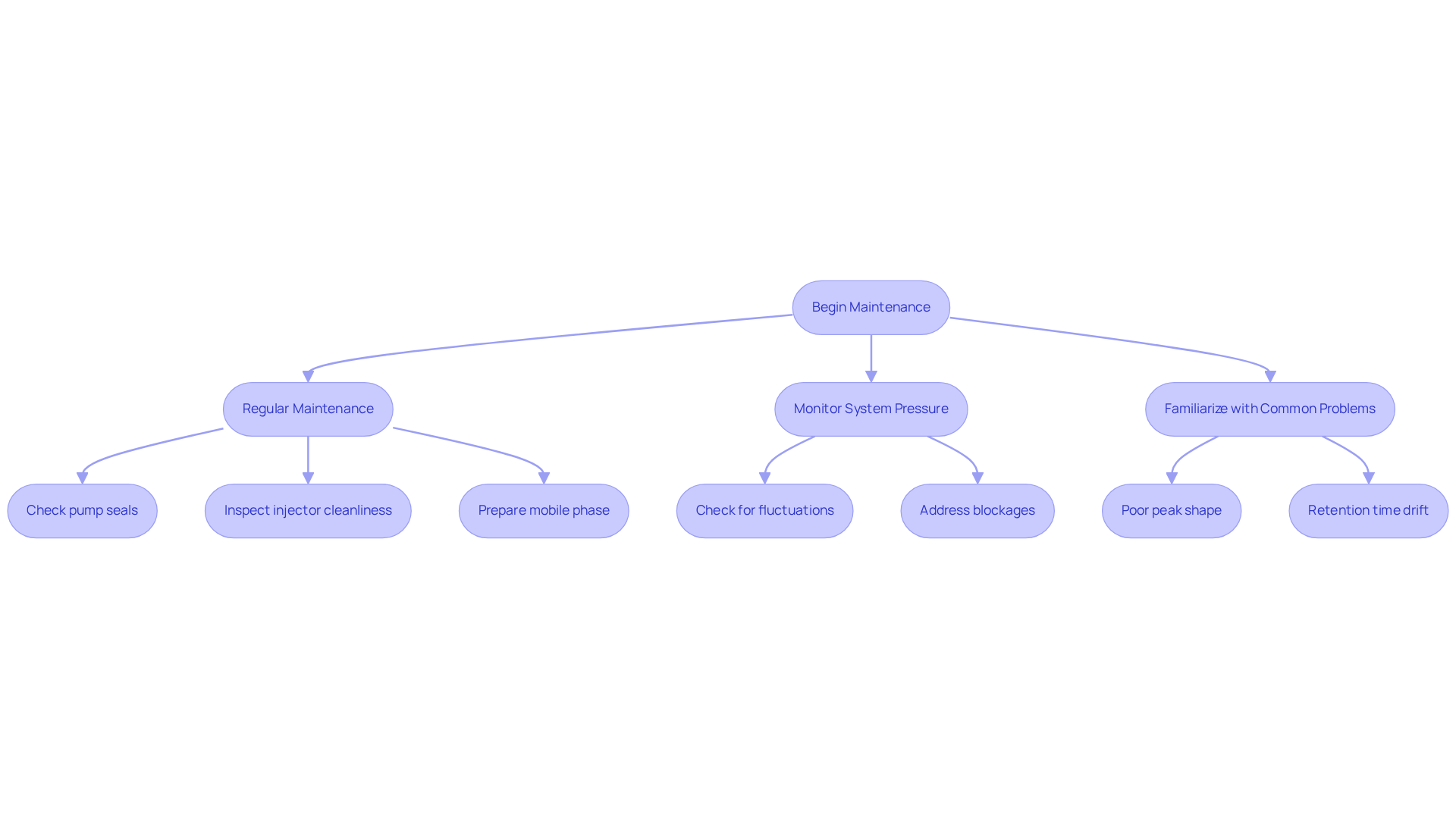Overview
This article centers on the optimization of High-Performance Liquid Chromatography (HPLC) methods, highlighting the selection of appropriate columns for effective protein analysis. Understanding key factors such as:
- Hydrophobicity
- Charge
- Size
is crucial for method selection. Additionally, the significance of column type, pore size, and stationary phase chemistry cannot be overstated, as these elements collectively enhance separation efficiency and analytical outcomes in laboratory settings. By focusing on these critical aspects, researchers can significantly improve their analytical processes, leading to more reliable and reproducible results.
Introduction
High-Performance Liquid Chromatography (HPLC) is a cornerstone in protein analysis, empowering scientists to separate, identify, and quantify biomolecules with exceptional precision. As protein mixtures become increasingly complex, optimizing HPLC methods and selecting the appropriate columns is crucial for achieving reliable results.
However, navigating the intricacies of HPLC—from grasping fundamental principles to troubleshooting common issues—presents significant challenges for researchers. To master HPLC for proteins and enhance analytical outcomes in this evolving field, it is essential to employ effective strategies.
Understand HPLC Fundamentals for Protein Analysis
High-Performance Liquid Chromatography (HPLC for proteins) serves as a robust analytical method essential for the separation, identification, and quantification of components within a mixture. In the context of peptide analysis, HPLC for proteins operates on the principle of differential partitioning between a mobile phase and a stationary phase contained within a column. Understanding the key factors influencing separation is paramount:
- Hydrophobicity: Proteins exhibit varying interactions with the stationary phase based on their hydrophobic characteristics, a crucial aspect for methods such as reverse-phase chromatography. This method achieves sensitivity ranges from ng/mL to µg/mL, proving effective for quantifying biomolecules in complex samples.
- Charge: Ion-exchange chromatography facilitates the separation of biomolecules according to their charge at a specified pH, enabling efficient purification processes. By adjusting the pH and ionic strength of the mobile phase, researchers can selectively bind and elute biomolecules, enhancing purification effectiveness.
- Size: Size exclusion chromatography (SEC) distinguishes macromolecules based on size, particularly beneficial for analyzing larger biomolecules without compromising their structural integrity.
A comprehensive understanding of these principles empowers researchers to select appropriate methods and conditions tailored to their specific analytical needs, ultimately leading to more reliable outcomes and streamlined workflows. For instance, the integration of advanced immunoassay systems, such as Luminex and Olink’s PEA, can significantly enhance chromatographic techniques by enabling high-throughput multiplex biomolecule analysis, illustrating the practical applications of chromatography in laboratory settings. Moreover, researchers must remain vigilant regarding common pitfalls, such as the potential interference from high-abundance substances that may obscure low-abundance substances in mass spectral analyses, to ensure the accuracy of their results.

Select Optimal HPLC Columns for Protein Separation
Selecting the right HPLC column is crucial for effective protein separation when utilizing HPLC for proteins, and several key considerations must be kept in mind.
- Column Type: The most common types include reverse-phase, ion-exchange, and size exclusion columns. Each type is tailored to specific characteristics of the substance and separation goals. For instance, reverse-phase media, particularly C18, are extensively utilized for larger macromolecules due to their hydrophobic interactions, while C4 media are better suited for smaller peptides.
- Pore Size and Particle Size: The pore dimensions of the structure are vital; larger pore sizes (300-4000 Å) accommodate bigger molecules, while smaller particles enhance resolution and reduce analysis duration. For small molecules, pore sizes of 60-160 Å are recommended, and for peptides, 120-300 Å is ideal. Furthermore, reducing particle size from 3.5 µm to 1.8 µm can double the column's efficiency, achieving approximately 24,000 theoretical plates, which significantly improves differentiation performance.
- Stationary Phase Chemistry: The choice of stationary phase greatly influences the retention and separation of biomolecules. C18 stationary phases are favored for their robust hydrophobic interactions, making them effective for a broad spectrum of biomolecules. Conversely, ion-exchange devices can be employed for proteins with varying charge characteristics, enabling tailored separation according to the protein's isoelectric point.
Current trends in high-performance liquid chromatography column selection emphasize the importance of aligning pore size with analyte size to avoid issues such as weak retention or low recovery. As chromatography specialists assert, 'Selecting the appropriate pore size guarantees robust analyte-stationary phase interaction,' which is essential for achieving sharp peaks and clear distinctions. Misapplication of pore sizes can lead to poor clarity and weak retention, highlighting the necessity for careful selection. Understanding these elements is crucial for refining , such as HPLC for proteins, ultimately enhancing laboratory effectiveness and precision.

Develop and Optimize HPLC Methods for Enhanced Results
To develop and , it is crucial to consider several key steps.
- Mobile Phase Composition: Adjusting the ratio of organic solvents, such as acetonitrile, to aqueous buffers can significantly impact protein retention and separation. In complex mixtures, a gradient elution may be necessary to achieve optimal results.
- Flow Rate: Optimizing the flow rate enhances resolution while reducing analysis time. A slower flow rate often improves separation but may increase run time, necessitating a balance between efficiency and quality.
- Temperature Control: Maintaining a consistent temperature is vital for improving reproducibility and peak shape. Certain molecules require specific temperatures to achieve optimal separation, highlighting the importance of precise temperature management.
Real-world applications demonstrate the effectiveness of gradient elution in separating closely related protein isoforms, a critical process in biopharmaceutical development utilizing HPLC for proteins. Regular method validation is essential to ensure that the developed methods meet the required analytical standards, reinforcing the need for rigorous quality control in laboratory practices.

Implement Maintenance and Troubleshooting Strategies for HPLC Systems
To maintain HPLC systems and troubleshoot common issues effectively, it is crucial to implement the following strategies:
- Regular maintenance is essential. Schedule routine checks for pump seals, injector cleanliness, and mobile phase preparation to prevent contamination and ensure consistent performance. This proactive approach not only safeguards the system but also enhances its reliability.
- Monitoring system pressure is another vital strategy. Regularly check for pressure fluctuations, as these can indicate blockages or leaks within the system. Addressing these issues promptly can prevent damage to the structure and other critical components, thereby preserving the integrity of the HPLC system.
- Familiarize yourself with common chromatography problems, such as poor peak shape, retention time drift, and baseline noise. For instance, if peak shape is distorted, investigate potential causes like air bubbles in the mobile phase or verify that the column is properly equilibrated. By understanding these challenges, you can take corrective actions swiftly.
By implementing these maintenance and troubleshooting strategies, laboratories can significantly enhance the reliability of their HPLC for proteins systems, ultimately leading to improved analytical outcomes.

Conclusion
High-Performance Liquid Chromatography (HPLC) stands as a crucial analytical technique for protein analysis, equipping researchers with the ability to separate, identify, and quantify biomolecules with precision. Mastery of HPLC necessitates a deep understanding of the fundamental principles of separation, the selection of optimal columns, and the development of methods that enhance analytical performance. By effectively leveraging these techniques, scientists can achieve reliable and precise results in their protein studies.
This article explores the key factors influencing HPLC performance, including:
- Hydrophobicity
- Charge
- Size
These factors are essential for selecting the appropriate methods and columns. In-depth discussions on column types, pore sizes, and stationary phase chemistry underscore the importance of aligning these elements with the specific characteristics of the proteins under analysis. Additionally, the optimization of mobile phase composition, flow rates, and temperature control emerges as critical steps in developing effective HPLC methods. Regular maintenance and troubleshooting strategies are vital for ensuring the reliability of HPLC systems.
In summary, mastering HPLC techniques for protein analysis not only enhances laboratory efficiency but also guarantees the accuracy of research outcomes. As the field continues to progress, remaining informed about best practices and advancements in HPLC methodologies will empower researchers to address complex challenges in protein analysis. By embracing these strategies, researchers will significantly contribute to the advancement of biopharmaceutical development and other pivotal areas of scientific inquiry.




